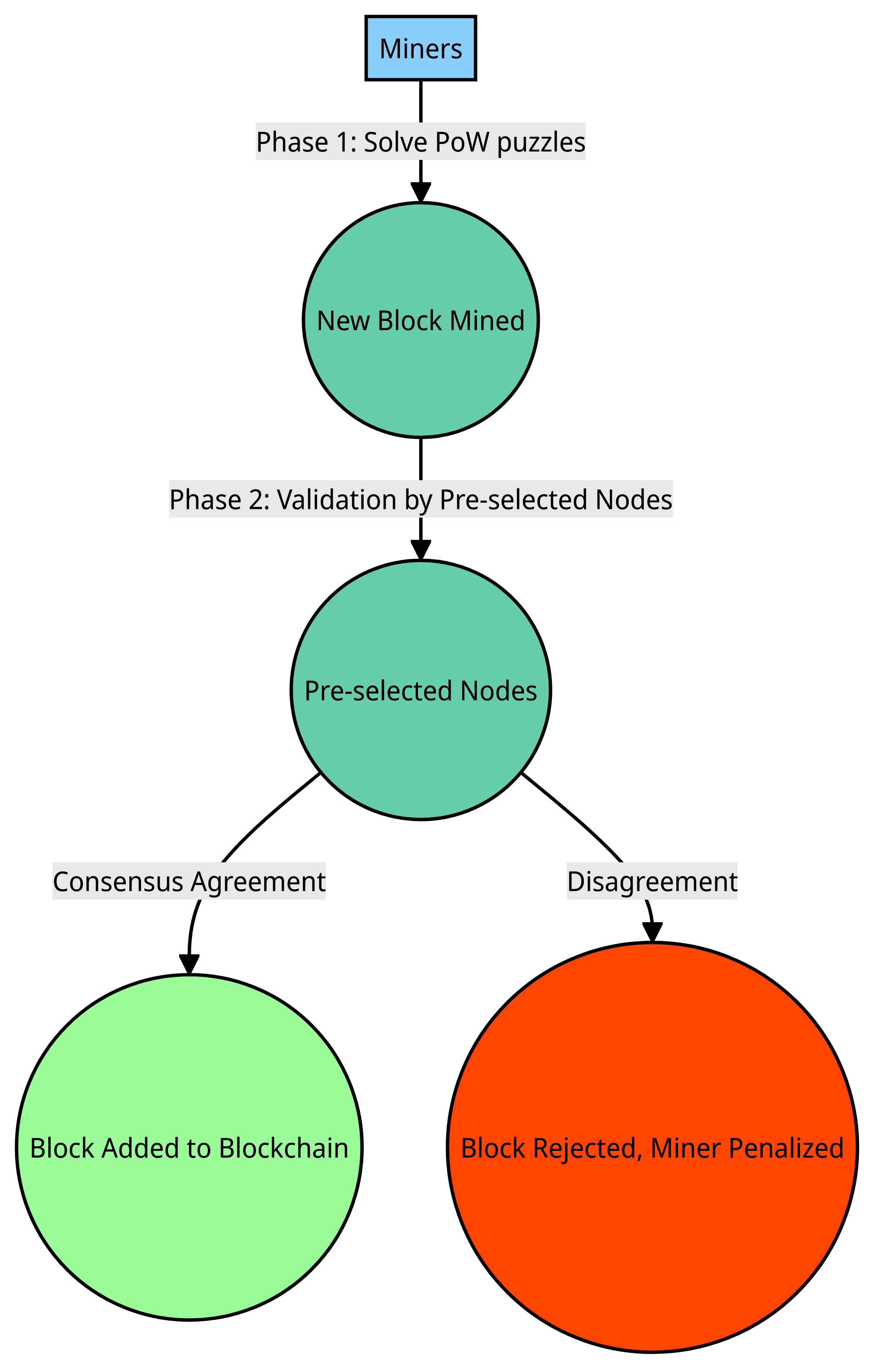Proof of Activity (PoA) is a revolutionary concept in the world of blockchain technology, reshaping the way we understand and validate transactions within decentralized networks. As the digital landscape continues to evolve, PoA stands as a beacon of innovation, offering a unique approach to consensus mechanisms that ensures security, efficiency, and transparency.
In this article, we will delve into the intricacies of PoA, exploring its fundamental principles, real-world applications, and the impact it has on the future of decentralized systems. Join us on a journey through the heart of PoA, unraveling its significance and uncovering the limitless possibilities it presents in the realm of blockchain.

What Is the Proof of Activity Hybrid Consensus Mechanism?
Proof of Activity is a hybrid consensus mechanism that combines elements of both proof of work (PoW) and proof of stake (PoS) to allow blockchains to leverage the strengths of each system.
As one of several hybrid consensus models, proof of activity aims to provide greater scalability, efficiency, decentralization and security for blockchain networks.
In this comprehensive guide, we’ll look at how proof of activity works, its benefits and drawbacks compared to other consensus algorithms, and some of the top blockchains using this hybrid approach.
How Does Proof of Activity Work?
Proof of activity is a clever hybrid consensus mechanism that blends proof of work with proof of stake to validate new blocks and secure the blockchain.

Here is an overview of how it works:
- Like PoW, miners compete to solve a cryptographic puzzle using computational power to create a valid block header. This determines who gets to generate the new block.
- The new block header is then broadcast to the network for the PoS validation phase.
- Validators who have staked coins on the network then attest that they accept the new block as valid and sign the block header.
- Once a majority of validators sign off on the new block, it is added to the blockchain.
- The miner who created the valid header also submits a reward address to claim their mining reward.
So in summary, PoA goes through two phases: PoW competition to create the block followed by PoS majority validation before the new block is ready to be added to the chain.
This hybrid approach aims to get the best of both worlds – the security of PoW mining combined with the efficiency and scalability potential of PoS validators.
5 Key Benefits of Proof of Activity (PoA)
There are several key potential benefits and advantages that proof of activity hybrid consensus offers over standalone PoW or PoS:
- Increased scalability – By separating block creation from validation, PoA parallelizes the work to allow more transactions per second.
- Leverages staked validators – Good security against possibly practical attacks only needs a subset of honest validators, unlike PoW which needs a majority control over mining power.
- Energy efficiency – PoW competition is contained to block creators rather than all miners, reducing energy use.
- Secure from major attacks – Adds another layer of protection against 51% attacks by dispersing control between miners and validators.
- Lower barriers to participate – Staking as a validator has lower requirements than expensive PoW mining hardware.
For these reasons, proof of activity aims to capture the best aspects of PoW security and PoS transaction efficiency within a hybrid consensus framework.
Potential Drawbacks and Risks
However, proof of activity also comes with some potential disadvantages and risks to consider:
- Increased complexity – The dual-phase approach adds extra steps and complexity vs single consensus models.
- Untested at scale – As a newer model, PoA remains less battle-tested than either PoW or PoS alone.
- Staking consolidation – PoS validation could centralize among a few large stakers thus reducing decentralization.
- Susceptible to DDoS – The PoW mining phase remains vulnerable to DDoS attacks.
- Higher latency – Waiting for validator signatures slows down block confirmation times.
While PoA offers theoretical improvements over PoW and PoS, real-world performance is still being evaluated, especially for applications that require high transaction throughput.
How Does Proof of Activity Compare to Other Hybrid Consensus Models?
Proof of activity is one of several hybrid consensus mechanisms that combine PoW and PoS in some form, including:
- Proof of Burn – Burns crypto coins to generate value for staking. Doesn’t use PoW mining.
- Proof of Importance – Prioritizes validators based on network activity and staked coins.
- Proof of Authority – Validators are approved centralized entities rather than miners and stakers.
- Delegated Proof of Stake – Coin holders vote for representative validators rather than participating directly in consensus.
PoA differs from these other hybrids by preserving the PoW mining process to create new blocks before passing to PoS validators for confirmation. This provides stronger security properties rooted in cryptographic hashes.
The diversity of hybrid models illustrates continued blockchain experimentation to find the right blend of decentralization, security, scalability and efficiency.
Real World Blockchain Projects Use Proof of Activity
Proof of Activity (PoA) is a consensus mechanism that is used by a number of real-world blockchain projects. Some of the most notable examples include:
- Decred: Decred is a cryptocurrency that was launched in 2014. It uses a hybrid PoW/PoS consensus mechanism, with PoA being used to validate blocks. Decred is known for its strong security and its focus on decentralization.
- Komodo: Komodo is a blockchain platform that allows users to create and manage their own cryptocurrencies. It uses a PoA consensus mechanism, which makes it a good choice for businesses and organizations that want to launch their own blockchain projects.
- Espers: Espers is a privacy-focused cryptocurrency that uses PoA. It is designed to be secure and anonymous, and it is popular among users who value their privacy.
- Vertcoin: Vertcoin is a cryptocurrency that was launched in 2014. It originally used a PoW consensus mechanism, but it switched to PoA in 2018. Vertcoin is known for its low transaction fees and its focus on decentralization.
In addition to these projects, there are a number of other real-world blockchain projects that use PoA. PoA is a relatively new consensus mechanism, but it is gaining popularity due to its energy efficiency, security, and decentralization.
Conclusion on Proof of Activity
Proof of activity offers a compelling path to blending the strengths of proof of work and proof of stake. By separating out block creation and validation, PoA can potentially provide greater scalability, energy efficiency, and security.
However, as a newer approach, it remains less proven than standalone models like pure PoW or PoS which are simpler mechanisms. Questions also persist around vulnerabilities if validator staking becomes too consolidated.
But as blockchain applications grow more complex, hybrid consensus systems like proof of activity may offer a more flexible framework for balancing critical needs like security, speed, cost and decentralization.
Ongoing advances around staking pools, sharded blockchains, crypto-economics and governance models will continue to shape the capabilities and viability of hybrid consensus.
While not a magic bullet, proof of activity represents an important evolutionary step in the development of robust and reliable blockchain consensus systems.
Summary of Main Points
- Proof of activity (PoA) combines PoW block creation with PoS validator signatures for hybrid consensus.
- PoA aims to leverage the strengths of both PoW security and PoS efficiency/scalability.
- Potential benefits include better scalability, energy efficiency, attack resistance and decentralization.
- Drawbacks include added complexity and concerns around staking consolidation.
- PoA differs from other hybrids like proof of burn by preserving PoW mining for block creation.
- Real world use cases are emerging for PoA across transactions, data provenance, databases and more.
- As a newer model, PoA still needs to demonstrate effectiveness at scale under varied conditions.
FAQs
What is Proof of Activity (PoA)?
Proof of Activity is a hybrid consensus mechanism that combines Proof of Work and Proof of Stake. It aims to leverage the strengths of both systems – the security of PoW with the efficiency of PoS.
How does Proof of Activity work?
PoA has two phases. First, miners compete to solve a puzzle and create a valid block using PoW. Next, PoS validators sign and approve the new block before it’s added to the blockchain.
What are the benefits of PoA consensus?
Potential benefits include improved scalability, energy efficiency, security against 51% attacks, and lower barriers to participation compared to pure PoW.
What are some risks and drawbacks of PoA?
Drawbacks include added complexity versus single consensus models, staking centralization risks, susceptibility to DDoS attacks in the PoW phase, and slower block confirmation times.
How does PoA compare to other hybrid consensus models?
PoA differs from hybrids like Proof of Burn and Proof of Importance by preserving PoW mining. This aims to leverage PoW’s strong security properties.
Is Proof of Activity a proven and mature consensus algorithm?
PoA is still relatively new and less battle-tested than standalone PoW or PoS. More real-world data is needed to evaluate PoA’s effectiveness at scale.
Can PoA achieve widespread adoption?
PoA shows promising potential if it can demonstrate reliability and prevent staking centralization. Hybrid consensus is a rapidly evolving field and PoA is an influential early iteration.







